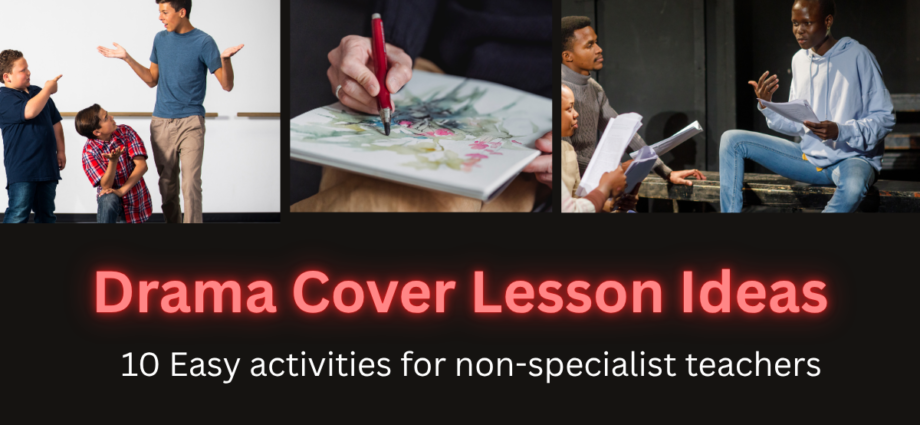You know the scene: you’re sick and you have 30 minutes to plan all your cover lessons for the day. Or you are the cover teacher and you see the dreaded word “DRAMA” on your timetable. You begin to sweat, and your stress bucket begins to fill! Panic not! Whether you’re a classroom teacher covering a lesson in the hall or a non-specialist trying to keep Year 8 entertained, this list of 10 quick, creative drama cover lessons will help things run smoothly.
All of these ideas are low-prep, high-engagement, and designed to work with minimal drama knowledge. Some are active, some are seated – so you can match the task to your setting and your students’ energy levels. You can download this list at the end of the article, too.
1. Freeze frames from a story
A simple, visual task that explores storytelling through still images.
What to do:
Ask students to create three freeze frames based on a story, scene or event. This could be a fairy tale, something from the news, or a story they’ve studied in English.
How to run it:
Students work in groups of 4–5. They should decide on three key moments and show them through body shape and facial expression only – no movement or sound. You might suggest a short performance title (e.g. The Robbery, The Escape, The Surprise Visit).
Stretch task: Ask them to add narration or a caption to each moment. Or include a thought-tracking element where the students voice their character’s thoughts in turn. If you are more confident with drama, you can get them to bring the scene to life for 30 seconds too.
2. Create a TV advert
An imaginative task that draws on persuasion, creativity, and group work.
What to do:
In small groups, students invent a product and create a short advert to sell it.
How to run it:
The product can be completely made up – from a plant that grows bottles of tomato sauce to an automatic cat stroker, honestly, the sillier the better! Give 10–15 minutes to plan and 1 minute each to perform. Encourage persuasive techniques, slogans, catchphrases and body language. Ask the groups to give feedback on the adverts to other students as peer feedback, but keep it positive and constructive.
Stretch task: Add a jingle, celebrity endorsement or a customer testimonial. Alternatively, ask them to draw a logo design for their particular product.

3. Create a character profile
A quiet, focused activity that explores character creation and interpretation – ideal for seated classroom work.
What to do:
Students invent an original character or choose a character from a familiar story, play or film. They then fill out a detailed character profile that explores the character’s personality, background and behaviour.
How to run it:
Give students prompts such as:
- Name, age, and occupation
- One secret the character is hiding
- How the character speaks and moves
- A typical day in their life
- Their biggest fear or goal
- How they behave in different situations (angry, nervous, proud)
Stretch task:
Ask students to write a short internal monologue (a stream of thoughts) or a diary entry from the character’s point of view.
Why it works:
This task helps students practise empathy, character development, and writing in role – all key skills in drama. It also provides written work that can be kept or assessed if needed.
4. Design a costume
A quiet, seated task that allows students to show creativity and character understanding.
What to do:
Ask students to design a costume for a character from a well-known play, story or even their own imagination.
How to run it:
If you have access to YouTube or a video of the play, show the students a short extract or a summary to remind them of the characters. Ask them to draw a costume (or two) for a character of their choice. They should label the costume features, noting why they’ve made certain choices (e.g. colour, fabric, era, accessories). This encourages character interpretation and design skills.
Stretch task: Students write a short explanation in the voice of the costume designer, justifying their choices, or act it out as if they were giving a presentation to the director.

5. Write a monologue
A writing-based activity that still connects with performance and emotion.
What to do:
Students choose a character – real, fictional or imagined – and write a short monologue from their perspective.
How to run it:
Give prompts such as: a moment before a big event, confessing a secret, or reflecting on a decision. Ask for 100–200 words. This can be kept private or performed if students are feeling more confident.
Stretch task: Add stage directions or suggest how tone and pace would change throughout. Ask them to perform it in a different accent.

6. Create a soundscape
Great for group work and imagination without needing to move around.
What to do:
Students create a sequence of sounds that represent a place or event – for example, a rainforest, war zone, haunted house or busy train station. Run this for at least 1-2 minutes.
How to run it:
In groups, they use only their voices and bodies (no props) to create the soundscape. You can play each group’s version while the others guess the setting.
Stretch task: Add a vocal narration over the top to turn it into a mini performance. Make one student the ‘conductor’ of the piece so they control the volume and intensity of the noises as if they were conducting an orchestra. Take it in turns to be the conductor.
7. Design a set
A perfect seated task for mixed-ability or end-of-day groups.
What to do:
Give students a brief scene description – such as a lonely cottage in the woods or a futuristic cityscape. Ask them to draw a set design for a stage performance.
How to run it:
They should include entrances/exits, levels, props and any symbolic elements that reflect the mood or theme. Tell them that they can set it in any way they like and money is no object. They can also design it for different stage types such as in-the-round, end-on etc.
Stretch task: Include a top-down stage plan as well as a front-on view.
8. Character walks and status lines
A physical activity that explores how we use our bodies to show status and emotion.
What to do:
Call out different characters or emotions (e.g. proud, scared, royalty, spy), and have students walk around the space showing that in their walk and how they talk to others.
When they have finished, ask them to write about what they did being specific about how they used their voice and body. (E.g. “I held my head high and walked slowly with a straight back”, or “I use a shrill, high pitch and spoke very fast”) Ask them to add an evaluation of what they did well and what they would change.
How to run it:
Pause occasionally and ask them to say a neutral line – such as “I need help” – in the voice of their character. This reveals how much impact status and body language have on delivery.
Stretch task: Pair students up and have them improvise a short meeting between two characters with very different status levels.
9. Mime a routine
A great go-to for structured silent performance.
What to do:
Ask students to mime a simple routine – e.g. getting ready for school, making a sandwich, training a dog – using clear, exaggerated movements and no sound.
Get them to mime it backwards, or at different speeds.
How to run it:
This can be solo or in pairs. Remind them to think about space, timing, and clarity.
Stretch task: Challenge students to include a twist, such as a disaster, interruption or surprise visitor. Ask them to describe exactly what they did without using the overall description. For example, if they were ‘cleaning their teeth’ they cannot use these words in the description but have to find alternative to describe specifically what they were doing.
10. What happens next? – script starter
An ideal task for creative writing and story development.
What to do:
Give students the first few lines of a made-up scene. Their job is to complete the script.
Example starter:
A: Did you hear that noise?
B: It came from the attic. Again.
A: That’s the third time this week…
Or
A: I think we’re getting faster
B: I know, and the brakes are not working
A: What are we going to do?…
How to run it:
Students continue the scene, adding at least 10 lines of dialogue. Encourage the use of stage directions and character names.
Stretch task: After writing, ask students to read it in pairs using tone, volume and gesture.
Final thoughts
Whether you’re a seasoned teacher or have been dropped into the drama studio with zero warning, these ready-made activities are designed to support you. No costumes, no scripts, no stress – just straightforward tasks that get students thinking, moving and collaborating.
You could even print these out and keep them in the staffroom as a go-to Drama Cover Toolkit!
DOWNLOAD HERE: You can also download a pdf version of this list here.
And one last word – break a leg!

Related posts
How to use Maths in a Drama Class
Basic acting techniques for beginners
Sunday Shakespeare: “Nothing will come of nothing”



This website is a great resource for drama teachers, as it gives so many fabulous ideas that they can use in their classes. Hell when in a bind you can even get a quick lesson plan here to save some time and effort.
I am a dance teacher and I can use these ideas too, using famous ballets as examples. I also like the activity when they work in groups and create an advert. That will be a lot of fun to try out and it gets their imaginations working for a change.
Hi Michel. Thanks so much for your kind comments and I’m so pleased that you feel you can use some of the ideas in your dance class. I also teach dance and have used many drama ideas in dance and vice versa. Please do come back soon or join our Facebook page so you can see when we post new information. There will be some info specifically for dance teachers soon too.
All the best. Gail
I really like these drama ideas! They seem easy to do even if you’re not a drama expert, which is super helpful. I’ve tried freeze frames before, and they’re a fun way to get everyone involved. My only question is, how do you keep students focused during improvisation when some might feel shy? Overall, great tips for making drama lessons stress-free and fun!
Hi Elena
Thanks for your kind comments on this site and I’m pleased you found the ideas helpful. They are designed to help non-specialist teachers who can often feel a little overwhelmed when covering a drama class so hopefully they are, as you say, easy to follow.
To answer your question, I’ve found that even students who are a little shy will get involved in some way, even if it is taking a small, non-speaking role, or become an onlooker. It’s important to encourage but not push people into acting roles if they really are not comfortable, but you can encourage them to be the director, suggest ideas, stand on the side, with some placards or be the ‘sound engineer’ and add some relevant music or sounds to the piece. Drama is a multi-faceted subject, and there are always ways that people can get involved. Our skill as a teacher is to find and encourage them.